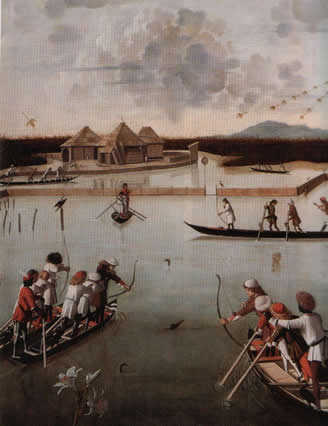A bureaucratic letter written by an important courtier, Cassiodoro , from the period of the Gothic kingdom in Italy (493-553 ad) provides us with some interesting details about how the inhabitants of the lagoon lived after the fall of the Roman Empire. Written in the autumn of 537 ad and transcribed in his work entitled “Variae”, Cassiodoro addresses the “battellieri” (watermen) of the coastal towns in the Venice area entrusted by the Goths with transporting food from Istria to their headquarters in Ravenna.
The trade route followed the various waterways behind and protected by the sandbanks along the coast: marshes, manmade canals, estuaries and lagoon pools. This was an ancient route, a valid alternative to roads or sea, allowing men and cargo to travel even during the winter months or bad weather . Small flat-bottomed barges were used, at times pulled along by the sailors using the so-called “alaggio” mooring system.
Hence the picturesque image of these “boats that seemed to sail across the fields, pulled along the banks by ropes” and the paradox of men transporting the boats and not the other way round.
The inhabitants of the lagoon settlements were often engaged in maritime activities. In fact, Cassiodoro describes their vessels, rather than animals, as being typically tied up outside the lagoon houses . He also recalls the common means of sustenance for the local population: fish (the basis of their diet) and salt (their most important economic resource along the northern coast of the upper reaches of the Adriatic). “But every effort is made to exploit the salt marshes: instead of ploughs and scythes, you turn rollers (i.e. the rollers needed to level the soil in the evaporation pools); this is the source of your income, whether you work your own land or simply rent it out. You could say that these pools act as a kind of food-based currency. Every wave adds to your business. Some people may well dream of finding gold, but everyone wants to find salt, and rightly so as all dishes owe their taste to salt.”
In practice, salt was not just used to enhance the flavour of food, but was mainly used to dry food (and thus preserve it) and was added to the fodder for sheep, common throughout the region of Venice, one of the cornerstones of its economy having always been the provision of pasture for flocks on the move and the resulting wool industry. Cassiodoro’s writings also seem to imply the use of salt as a bartering tool, letting us understand that salt was widely traded and a valuable commodity.
The letter also gives us an insight into how people lived in those days. Much to be regretted was the decline of the old Roman villas along the Adriatic coast, places once greatly admired by the Roman poet Martial who compared them with their more famous counterparts in Campania. By the time the Goths occupied Italy these must have had an abandoned, ruined look; it would appear that the Goths preferred smaller houses along the lagoon, there being no obvious distinction between the rich and the poor. Their dwellings were built on a framework of reeds and beaten earth floors, though Cassidoro compared them to fragile birds’ nests, as they were raised above the ground and the water.
However, the most striking aspect of the environment for Cassiodoro and various other writers of the time was the phenomenon of the tides that caused the locals to be called alternatively islanders and mainlanders, depending on the ebb and flow of the water. The tides were responsible for creating a delicate ecosystem that was perfectly healthy, thanks to both Nature and man’s intervention.
Thus the nature of the human settlements that emerges from Cassiodoro’s writing is that of a concentration on the lagoon islands, everyone sharing the same lifestyle and totally dedicated to the resources of that “marsh economy” that the Roman’s had considered of only minor importance, though by no means lacking vitality.
Giovannella Cresci Marrone




